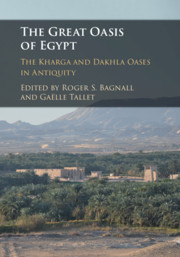Book contents
- The Great Oasis of Egypt
- The Great Oasis of Egypt
- Copyright page
- Contents
- Figures
- Tables
- Contributors
- Preface
- 1 Introduction
- Part I Living in the Oasis: Humans and the Environment
- Part II Managing the Oasis
- 5 The Great Oasis: An Administrative Entity from Pharaonic Times to Roman Times
- 6 Land and Resource Administration: Farmers, Managers, and Soldiers in the Great Oasis
- 7 What Remains in the Hands of the Gods: Taxation in Kharga Oasis through the Demotic Ostraca (Fifth Century BC to First Century AD)
- Part III Trade and Mobility in a Connected Environment
- Part IV An Oasis Culture?
- Bibliography
- Index of ancient people
- Index of places
- General index
7 - What Remains in the Hands of the Gods: Taxation in Kharga Oasis through the Demotic Ostraca (Fifth Century BC to First Century AD)
from Part II - Managing the Oasis
Published online by Cambridge University Press: 12 July 2019
- The Great Oasis of Egypt
- The Great Oasis of Egypt
- Copyright page
- Contents
- Figures
- Tables
- Contributors
- Preface
- 1 Introduction
- Part I Living in the Oasis: Humans and the Environment
- Part II Managing the Oasis
- 5 The Great Oasis: An Administrative Entity from Pharaonic Times to Roman Times
- 6 Land and Resource Administration: Farmers, Managers, and Soldiers in the Great Oasis
- 7 What Remains in the Hands of the Gods: Taxation in Kharga Oasis through the Demotic Ostraca (Fifth Century BC to First Century AD)
- Part III Trade and Mobility in a Connected Environment
- Part IV An Oasis Culture?
- Bibliography
- Index of ancient people
- Index of places
- General index
Summary
More than thirty years of excavations in Kharga Oasis yielded a large amount of Demotic ostraca providing information about the tax systems in place in this remote area of the Egyptian Western Desert. In this chapter I propose an overview of the Demotic fiscal documentation emanating from various settlements of the Great Oasis considered (part 1). These texts provide insights on the multiple tax systems set up by state as well as by local temples in the longue durée of the second part of first millennium BC. The king seems to have levied taxes at the district and the village levels while the temples took an amount from the harvests of their tenants. In this context, the temple of Amun of Hibis of Kharga appears as the religious institution that owned the most land in the whole oasis (part 2). It helps also to know the nature of the taxes - in cereal, in oil for lighting - and attests to the existence of a form of banalité required for the use of a mill (part 3).
Keywords
- Type
- Chapter
- Information
- The Great Oasis of EgyptThe Kharga and Dakhla Oases in Antiquity, pp. 122 - 132Publisher: Cambridge University PressPrint publication year: 2019
- 2
- Cited by

